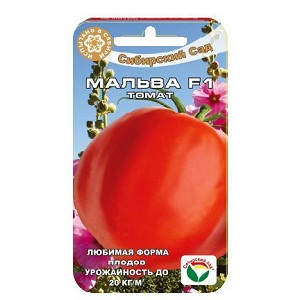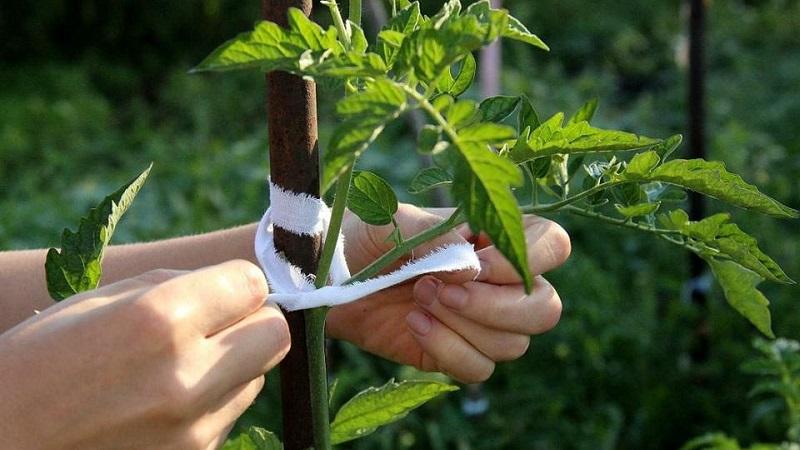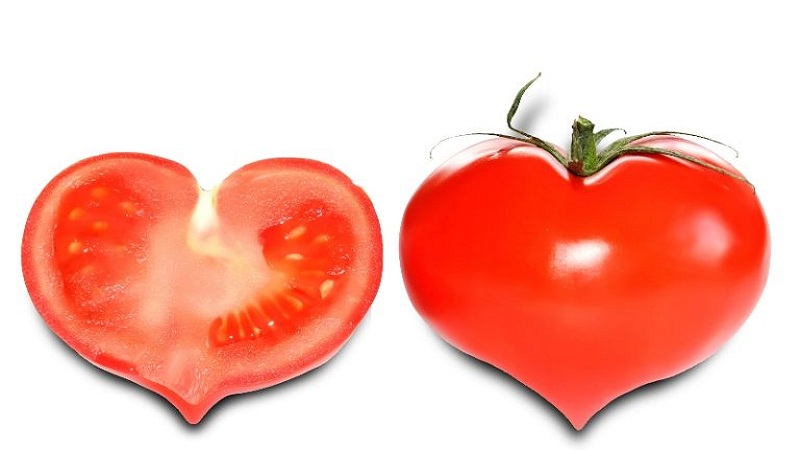Lying variety for salads and preservation - hybrid tomato "Malva f1"
Tomato Malva f1 is an early ripe hybrid with excellent taste, unpretentious care and resistance to viruses. The fruits are in great demand among buyers due to their beautiful shape, resembling large strawberries.
In this article, we will talk about the distinctive features of culture and the nuances of its agricultural technology.
The content of the article
Description of the hybrid
The Malva f1 hybrid appeared on the market recently. It was included in the State Register of Plants in 2018. The culture is intended for planting in open and closed ground. Bushes are medium-leafy, need to be pinned and formed into 1-2 stems.
In the photo - tomatoes Malva f1.

Distinctive features are presented in the table.
| Indicators | Characteristic |
| Weight | 160-190 g |
| The form | Fruits are heart-shaped, slightly ribbed, with a sharp nose, reminiscent of garden strawberries. |
| Coloration | Ripe tomatoes are bright red. |
| Leaves | Medium in size, green. |
| Inflorescence | Simple with 4-6 slots. |
| Peduncle | With articulation. |
| Taste qualities | The taste is sweet, with a pleasant sourness. |
| Skin | Tight and resilient, does not crack. |
| Height | Bushes indeterminate, grow up to 1.8 m. |
| Ripening period | 90–92 days from the moment of emergence. |
| Yield | 21-22 kg from 1 m². |
| Sustainability | To Alternaria and Mosaic Virus. |
Growing and caring for tomatoes
The cultivation of Malva f1 tomatoes is not much different from the cultivation of other hybrids. Care is organized according to the standard scheme: preparation of the substrate, sowing, growing seedlings, planting in open or closed ground, caring for plants.
Sowing seeds
Tomatoes Malva f1 are cultivated in all regions of Russia. Sowing seeds begins approximately 55–65 days before planting in the soil. Seedlings appear in 5-10 days. In order not to overexpose the seedlings on the windowsill, it is important to know when the spring frosts end.
Sowing seeds for seedlings for open ground begin:
- in the southern regions: late February - early March;
- in the central regions: mid-March - early April;
- in the northern regions: the first and second ten days of April.
If you plan to plant in greenhouses, sowing is carried out 2-3 weeks earlier.

Mallow f1 hybrid seeds do not need to be disinfected and germinated, but disinfection of soil for seedlings will not be superfluous. This applies to both the land from the garden and the finished substrate for tomatoes from flower shops. The soil is calcined in an oven at 200 ° C for 15 minutes and left to cool. The second popular method is disinfection with a strong solution of potassium permanganate.
Experienced gardeners recommend postponing sowing for 10 days and wait until beneficial bacteria appear in the soil... Then the prepared container is filled with a moist substrate and grooves are made 1 cm deep. The seeds are sown at a distance of 2 cm, covered with a small layer of soil on top and covered with foil. The optimum temperature for germination is +25 ° C.
Seedling care
The containers are placed in a warm place and wait for seedlings. The film is removed once a day for 10-15 minutes to ventilate the soil. After the first leaves appear, the pots are taken out to the lightest place. South-facing window sills are ideal. A phytolamp is used as an additional light source.
Seedlings are watered at the root as the soil dries. In order not to damage the delicate sprouts, use a pipette or syringe without a needle.
As soon as warm, sunny weather sets in, the seedlings are transferred to fresh air. For the first time, 5 minutes is enough.Each day, the time is gradually increased by 5 minutes.
Seedlings are fertilized every 2 weeks after germination. Organic poultry manure is best suited.
A dive into peat or plastic glasses is carried out after the appearance of 2-3 true leaves.
Planting seedlings
After the seedlings release the first flower clusters, count down 10-15 days and begin to prepare the soil for transferring the shoots. The soil is dug up, loosened and disinfected with boiling water or a solution of potassium permanganate. Pits are dug to a depth of 15–20 cm. No more than 4 bushes are planted for each square meter. The distance between the seedlings is 30–40 cm.
reference... The best soil for tomatoes is black soil mixed with peat.
Seedlings are planted on a cloudy day or in the evening. The soil is watered with warm, settled water.
Tomato care

Caring for Mallow tomatoes is standard. The plant is unpretentious and only needs periodic weeding, moderate watering and fertilization.
Step sonsindeterminate bushes without fail, forming 1-2 stems, which grow up to 2 meters and require a garter.
Mulching soil with peat, hay or sawdust allows you to reduce the number of weeding and irrigation, since it stops the growth of weeds and retains moisture in the soil.
2-3 weeks after planting, the seedlings begin feed... This is necessary to strengthen the plants. For the first time, nitrogen is used in combination with phosphorus and potassium.
Take note of several options for combined fertilizers (calculated per 10 liters of water):
- 500 ml liquid mullein, 1 tbsp. l. nitrophosphate;
- 500 ml chicken droppings, 1 tbsp. l. superphosphate, 1 tsp. potassium sulfate;
- 50 g of ash, 30 g of superphosphate, 3 g of boric acid, 3 g of manganese sulfate, 1 liter of mullein.
From the moment the ovaries appear, they switch to potassium-phosphorus fertilizing (calculated per 10 liters of water):
- 500 g of ash;
- 1 tbsp. l. superphosphate, 1 tsp. potassium sulfate;
- 2 tbsp. l. ash, 1 tbsp. l. superphosphate;
- 1 tbsp. l. nitrophosphate, 1 tsp. potassium humate;
- 10 g of potassium nitrate, 25 g of magnesium sulfate.
reference... The rules for caring for mallow tomatoes growing in greenhouses and in the open air do not differ in any way.
Diseases and pests
Mallow f1 hybrid is resistant to many viral diseases of tomatoes. For prevention late blightthe bushes are treated with various preparations: "Ordan", "Topaz", "Fundazol", "HOM", "Tiovit Jet".
Folk remedies for combating late blight have proven themselves well:
- garlic infusion;
- kefir and salt spraying;
- milk with iodine;
- ash;
- infusion of tinder fungus;
- wrapping the roots with copper wire.
The first treatment is carried out after the appearance of 4-6 true leaves, the next - after 7-10 days. Processing is stopped 20 days before harvest.
"Confidor" helps to get rid of whiteflies and aphids. Slugs are afraid of lime, ash and tobacco dust. The fight against spider mites is carried out using a soap solution or garlic infusion.
Growing difficulties
Hybrid Malva f1 is picky about the quality of the soil. To prevent the plant from going into the stage of vegetative growth (fattening), when the green mass is actively growing and the number of ovaries is reduced, the soil is enriched with humic substances (peat, sapropel, brown coal). This is done before the seedlings are planted, because then it is very difficult to change the composition of the soil.

Than threatens fattening for plants? Fruiting is significantly reduced, which negatively affects the profitability of cultivation. Irrigating the bushes with growth stimulants with sodium humate in the composition and feeding with superphosphate helps to correct the situation.
Watch the video on the fight against fattening of tomatoes at the end of the article.
Harvesting and application of the crop
The first crop is harvested about 3 months after germination. Tomatoes are used for pickling, salting, making adjika, juice, sauces, pasta.
The fruits are good fresh in light vegetable salads.

Advantages and disadvantages
Hybrid Malva f1 has the following advantages:
- early maturation in open and closed ground;
- high yield regardless of the place of growth;
- attractive fruit shape;
- small size allows the use of tomatoes for canning;
- high taste;
- excellent keeping quality;
- the possibility of transportation over long distances;
- resistance to viral diseases of nightshade.
The hybrid has not so many disadvantages:
- the need for a garter and formation of a bush;
- active growth of green mass when planting in poorly nutritious soil.
Reviews
Despite the novelty of the Malva f1 hybrid, many have appreciated its benefits.
Vadim, Volgodonsk, Rostov region: “The Malva tomato variety started growing last year. He collected the harvest in buckets, did not know what to do with it. Selling, distributing, winding the blanks for several years in advance. The culture is absolutely unpretentious in its care. For the sake of experiment, I planted it in a film greenhouse and in a vegetable garden - the result is the same. "
Irina, Gorokhovets, Vladimir region: “I bought seeds Malva f1 for the sake of interest last year. The description states that tomatoes are suitable for growing in all conditions. I planted some bushes in a greenhouse. The result exceeded all expectations. A very fertile culture, easy to care for, the main thing is to water, fertilize and protect from pests in moderation. Tomatoes have an interesting shape, with pointed noses. The taste is excellent, sweet and sour. The tomatoes were eaten fresh and pickled. "
Conclusion
Tomatoes Malva f1 have surprisingly high yields - 21-22 kg per 1 m². Long shelf life and the ability to transport over long distances without deteriorating appearance make the hybrid popular among gardeners and farmers.
The fruits are characterized by pleasant taste and are suitable for fresh and canned consumption.